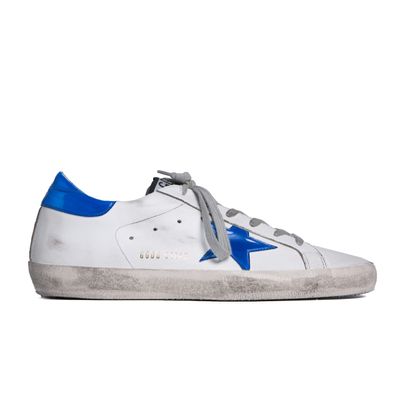
In 2017, everyone’s talking about “ugly” sneakers, from Balenciaga’s bulky, gorpcore Triple S shoes to Acne’s exaggerated, Bill-Clinton-on-a-jog look. But sneakers have always been pretty “ugly” (emphasis on the Virgil Abloh air quotes), and none more purposefully so than those of Golden Goose.
Ten years ago, the Italian luxury sneaker brand arguably started the trend with its pre-distressed, leather Superstar sneakers, which cost from $300 to $600 dollars. “Pre-distressed” is putting it nicely; even when covered in crystals, these kicks looked busted, as though they’d already spent years pounding the grimy New York pavement. But that was the point, and influencers and Barneys customers were willing to pay such a steep price for seemingly used footwear because they were unlike anything else on the market. They embodied a kind of lowbrow luxury that, clearly, people still want today.
“In 2007, there wasn’t a fashion sneaker like Golden Goose,” says Marina Larroude, the fashion director at Barneys New York, of the Superstar sneaker. “There were the sportswear brands and then the high-end fashion houses who produced very precious sneaker styles, but there was no real in-between. Golden Goose filled that void by providing a fashion sneaker that look polished and cool, but was not too precious.”
Luxury brands like Gucci, Prada, and Lanvin have always offered their take on fashion sneakers. And the early 2000s saw the rise of Isabel Marant’s wedge sneaker and Christian Louboutin’s studded slip-ons, both of which, objectively speaking, were um, a lot on the eyes. But at the time, some of the only young sneaker brands on the luxury market were Golden Goose and Common Projects, which introduced clean leather sneakers that embodied a kind of quiet preciousness, also known as minimalism.
A decade later, Common Projects and Golden Goose are both still status symbols in fashion — their customers want you to know they spent $300-something on sneakers — but Golden Goose’s power lies in its disguise or mocking of luxury, whereas Common Projects indulges in the idea that luxury can be quotidian.
Golden Goose founders Alessandro Gallo and Francesca Rinaldo describe the Superstar sneakers as being an “emotional product that is authentic and never artificial.” They look as though they’ve already lived a good life, full of adventure, and encourage you to do more of the same. You can wear them anywhere, in any social situation. (Whereas if I see a puddle while wearing my Common Projects, I’ll cross the street.) The duo also added that the Superstars are “unconnected with the [fashion] sector’s typical rules and principles,” referencing the typical glean of high-fashion. They’re meant to blend in among the every-man, while still catching the attention of those in the know.
We have a word for this now: “They helped to herald the emergence of normcore,” said Leandra Medine, who started wearing Superstar Golden Goose sneakers because they had a hidden wedge in the heel.
When asked if the Golden Goose Superstars predicted the “ugly” sneakers trend, too, Medine agreed, saying that they were “one of the first deliberately scuffed offerings at market” and symbolized a larger cultural shift in how we display wealth today. “No more gold toilet seats,” she added.
Despite the fact that we elected a billionaire businessman to be our president — or perhaps in spite of this — overt displays of wealth are frowned upon these days. The recent Louise Linton Instagram incident is perhaps the best example of this, but it’s also borne out through the popularity of designer baseball caps and $2,145 Ikea bags. If Linton had hashtagged Golden Goose instead of Hermès, though, would people have reacted differently?
In addition to the political comfort of hiding one’s wealth with $300 dirty sneakers, there’s also an emotional comfort to a pair of Golden Goose Superstar sneakers. “[People] don’t want to look too precious any more, and don’t want to look like they’re trying too hard,” concluded Larroude. “It’s somewhat outdated to look too put-together. Millennials especially want to wear things that put off an easygoing air.”
Ten years ago, when the Golden Goose Superstar was first released, “ugly” was different; today, it’s a badge of honor. We’ve got the rapper Ugly God; a model with 323,000 followers whose Instagram handle is @UglyWorldwide; and high-fashion designers like Miuccia Prada calling their own collections “ugly.”
To quote Beyoncé, “pretty hurts.” Ugly sells.


